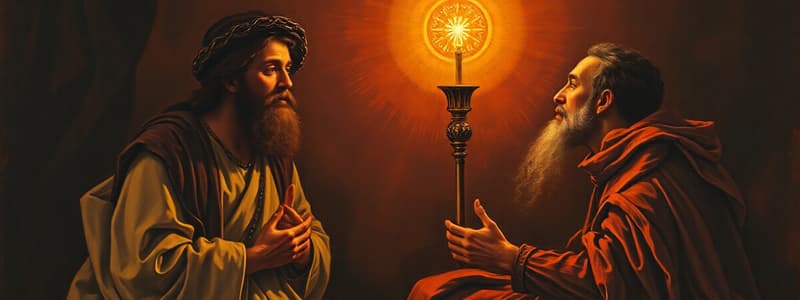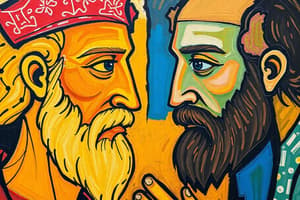Podcast
Questions and Answers
Which of the following statements accurately reflects Augustine's view on the relationship between action and contemplation?
Which of the following statements accurately reflects Augustine's view on the relationship between action and contemplation?
- Action and contemplation are separate and distinct, with no connection to each other.
- Action and contemplation are mutually exclusive, each serving a different purpose in the spiritual journey.
- Action is necessary only in the early stages of spiritual growth, while contemplation dominates later stages.
- Contemplation is the ultimate goal of all action, providing fulfillment and perfection. (correct)
According to Augustine, which of the following best represents 'vita activa'?
According to Augustine, which of the following best represents 'vita activa'?
- Focused contemplation on the nature of God and the mysteries of the universe.
- The pursuit of knowledge and understanding of divine truths.
- The active engagement in the world, including works of faith and moral living. (correct)
- A life dedicated to the pursuit of personal salvation and heavenly rewards.
What does Augustine's interpretation of Lia and Rachel symbolize in relation to spiritual growth?
What does Augustine's interpretation of Lia and Rachel symbolize in relation to spiritual growth?
- The conflict between earthly desires and spiritual aspirations.
- The contrasting roles of men and women in the pursuit of spiritual fulfillment.
- The importance of both practical virtues and theoretical knowledge in achieving wisdom.
- The progress from a life of action to a life of contemplation. (correct)
Which of the following best represents Augustine's view on the role of the Holy Spirit in spiritual progress?
Which of the following best represents Augustine's view on the role of the Holy Spirit in spiritual progress?
In Augustine's framework, what is the primary function of 'virtus activa'?
In Augustine's framework, what is the primary function of 'virtus activa'?
How does Augustine connect his interpretation of Lia and Rachel to the union of the soul with God?
How does Augustine connect his interpretation of Lia and Rachel to the union of the soul with God?
Which of the following best describes the relationship between 'virtus activa' and 'virtus contemplativa'?
Which of the following best describes the relationship between 'virtus activa' and 'virtus contemplativa'?
What is the significance of Dante's portrayal of Lia and Rachel in Purgatorio?
What is the significance of Dante's portrayal of Lia and Rachel in Purgatorio?
Which of the following best exemplifies the concept of 'vita contemplativa' as described by Augustine?
Which of the following best exemplifies the concept of 'vita contemplativa' as described by Augustine?
How does Augustine's doctrine of 'vita activa' and 'vita contemplativa' contribute to a practical roadmap for spiritual growth?
How does Augustine's doctrine of 'vita activa' and 'vita contemplativa' contribute to a practical roadmap for spiritual growth?
What is the primary aim of pagan philosophers in their contemplation?
What is the primary aim of pagan philosophers in their contemplation?
How does Augustine's influence on contemplation differ from that of Aquinas?
How does Augustine's influence on contemplation differ from that of Aquinas?
What is emphasized in both contemplative and active lives according to Gregory?
What is emphasized in both contemplative and active lives according to Gregory?
In what way does the concept of 'Vita Contemplativa' differ in Christian thought compared to its pagan roots?
In what way does the concept of 'Vita Contemplativa' differ in Christian thought compared to its pagan roots?
Which figure is noted for having significantly influenced Aquinas' understanding of the two lives?
Which figure is noted for having significantly influenced Aquinas' understanding of the two lives?
What is the Greek equivalent of 'activus' as described in the content?
What is the Greek equivalent of 'activus' as described in the content?
Which life did Plato elevate in importance by merging it with civic responsibilities?
Which life did Plato elevate in importance by merging it with civic responsibilities?
In Plato's Republic, what is required to achieve contemplation?
In Plato's Republic, what is required to achieve contemplation?
What was Plato’s view on philosophers and their role in society?
What was Plato’s view on philosophers and their role in society?
Which category did Plato likely draw inspiration from when classifying lives?
Which category did Plato likely draw inspiration from when classifying lives?
What term describes Plato's philosophical exploration of divine beauty and contemplation?
What term describes Plato's philosophical exploration of divine beauty and contemplation?
How did St. Augustine's view of contemplation differ from Plato's?
How did St. Augustine's view of contemplation differ from Plato's?
What philosophical concept was emphasized in Plato’s dialogues contrary to the Greek focus on action?
What philosophical concept was emphasized in Plato’s dialogues contrary to the Greek focus on action?
Which aspect characterizes the θεωρητικός life in Plato's classification of lives?
Which aspect characterizes the θεωρητικός life in Plato's classification of lives?
Which of the following is NOT considered a characteristic of the 'contemplative life' according to the historical and modern definitions discussed in the text?
Which of the following is NOT considered a characteristic of the 'contemplative life' according to the historical and modern definitions discussed in the text?
Pope St. Gregory the Great's use of the terms 'active' and 'contemplative' differed significantly from their modern interpretations. What is the main implication of this difference for understanding St. Thomas Aquinas's works, 'De Vita Contemplativa' and 'De Vita Activa'?
Pope St. Gregory the Great's use of the terms 'active' and 'contemplative' differed significantly from their modern interpretations. What is the main implication of this difference for understanding St. Thomas Aquinas's works, 'De Vita Contemplativa' and 'De Vita Activa'?
Which of the following statements accurately describes the evolution of religious life as presented in the text?
Which of the following statements accurately describes the evolution of religious life as presented in the text?
The text mentions that 'strict enclosure for religious women dates to 1298 with the Constitution Periculoso by Boniface VIII.' What was the likely impact of this constitution?
The text mentions that 'strict enclosure for religious women dates to 1298 with the Constitution Periculoso by Boniface VIII.' What was the likely impact of this constitution?
According to the New Catholic Dictionary, what are the two fundamental aspects of the 'contemplative life'?
According to the New Catholic Dictionary, what are the two fundamental aspects of the 'contemplative life'?
The text highlights potential misunderstandings in the modern interpretation of St. Gregory the Great's terms. Which of the following represents a potential misunderstanding?
The text highlights potential misunderstandings in the modern interpretation of St. Gregory the Great's terms. Which of the following represents a potential misunderstanding?
The text presents various perspectives on the 'active' and 'contemplative' life. Which of the following aspects of the 'active' and 'contemplative' life are consistently present in all the different sources cited in the text?
The text presents various perspectives on the 'active' and 'contemplative' life. Which of the following aspects of the 'active' and 'contemplative' life are consistently present in all the different sources cited in the text?
What primary factor motivated Augustine to develop his theological insights?
What primary factor motivated Augustine to develop his theological insights?
What makes Augustine's approach to contemplation unique?
What makes Augustine's approach to contemplation unique?
The text suggests that Augustine's understanding of contemplation differed from some prior thinkers in which way?
The text suggests that Augustine's understanding of contemplation differed from some prior thinkers in which way?
According to Augustine, what is the primary object of both philosophical and religious contemplation?
According to Augustine, what is the primary object of both philosophical and religious contemplation?
What is the significance of Augustine's "Confessions" in relation to his concept of contemplation?
What is the significance of Augustine's "Confessions" in relation to his concept of contemplation?
How does the text characterize the relationship between St.Isidore of Seville and St.Augustine's ideas?
How does the text characterize the relationship between St.Isidore of Seville and St.Augustine's ideas?
What is the most important distinction between 'active life' and 'contemplative life' as defined by Augustine?
What is the most important distinction between 'active life' and 'contemplative life' as defined by Augustine?
In Augustine's framework, what is the relationship between the active and contemplative lives?
In Augustine's framework, what is the relationship between the active and contemplative lives?
What does Augustine's framework suggest about the accessibility of contemplation?
What does Augustine's framework suggest about the accessibility of contemplation?
What historical figure is cited as an example of excelling in the "active life" according to Augustine's framework?
What historical figure is cited as an example of excelling in the "active life" according to Augustine's framework?
Flashcards
Vita Activa
Vita Activa
A lifestyle focused on visible, external activities like teaching, nursing, and social work.
Vita Contemplativa
Vita Contemplativa
A lifestyle focused on prayer, spiritual reading, and seclusion from worldly activities.
Active Orders
Active Orders
Religious orders that focus on external works of mercy, such as teaching, healthcare, and social work.
Contemplative Orders
Contemplative Orders
Signup and view all the flashcards
Mixed Orders
Mixed Orders
Signup and view all the flashcards
Contemplative Life
Contemplative Life
Signup and view all the flashcards
Contemplative Life (Catholic Concise Encyclopedia)
Contemplative Life (Catholic Concise Encyclopedia)
Signup and view all the flashcards
θεωρία (Theoria)
θεωρία (Theoria)
Signup and view all the flashcards
πρακτικός (Praktikos)
πρακτικός (Praktikos)
Signup and view all the flashcards
βίος θεωρητικός (Contemplative Life)
βίος θεωρητικός (Contemplative Life)
Signup and view all the flashcards
Philosopher King
Philosopher King
Signup and view all the flashcards
Philosophers Returning to the Cave
Philosophers Returning to the Cave
Signup and view all the flashcards
Plato's Classification of Lives (Theoretical, Practical, Apolaustic)
Plato's Classification of Lives (Theoretical, Practical, Apolaustic)
Signup and view all the flashcards
St. Augustine
St. Augustine
Signup and view all the flashcards
Plato's Concept of Being
Plato's Concept of Being
Signup and view all the flashcards
Contemplation
Contemplation
Signup and view all the flashcards
Active Life
Active Life
Signup and view all the flashcards
Separate Lives
Separate Lives
Signup and view all the flashcards
United Lives
United Lives
Signup and view all the flashcards
Interior vs. Exterior
Interior vs. Exterior
Signup and view all the flashcards
Contemplation for All
Contemplation for All
Signup and view all the flashcards
Knowing and Loving God
Knowing and Loving God
Signup and view all the flashcards
God as Ultimate Source
God as Ultimate Source
Signup and view all the flashcards
Augustine's Confessions
Augustine's Confessions
Signup and view all the flashcards
Transience of Grace
Transience of Grace
Signup and view all the flashcards
Two Lives
Two Lives
Signup and view all the flashcards
Dark Ages
Dark Ages
Signup and view all the flashcards
Summa Theologiae
Summa Theologiae
Signup and view all the flashcards
Augustine's Platonist Influence
Augustine's Platonist Influence
Signup and view all the flashcards
Aquinas' Use of Gregory's Ideas
Aquinas' Use of Gregory's Ideas
Signup and view all the flashcards
Contemplation as the Goal
Contemplation as the Goal
Signup and view all the flashcards
Purity Before Contemplation
Purity Before Contemplation
Signup and view all the flashcards
Lia and Rachel Symbolism
Lia and Rachel Symbolism
Signup and view all the flashcards
Peter and John: Active and Contemplative
Peter and John: Active and Contemplative
Signup and view all the flashcards
Active and Contemplative Virtues
Active and Contemplative Virtues
Signup and view all the flashcards
Complementarity of Two Lives
Complementarity of Two Lives
Signup and view all the flashcards
Augustine's Unified Approach
Augustine's Unified Approach
Signup and view all the flashcards
The Importance of Contemplation
The Importance of Contemplation
Signup and view all the flashcards
Study Notes
Active and Contemplative Life
- Humans have historically categorized lifestyles into two main types:
- Active life (vita activa): Involves external, visible activities like teaching, nursing, and social work.
- Contemplative life (vita contemplativa): Focused on prayer, spiritual study, and seclusion from the world.
- Religious orders are categorized similarly:
- Active orders: Focus on apostolic work (e.g., Maryknoll Sisters).
- Contemplative orders: Engage in cloistered religious life (e.g., Carmelites, Trappistines).
- Historical Context: Pope Gregory the Great (540-604) used the terms "active" and "contemplative" differently than modern usage.
- The classification of religious orders into active and contemplative emerged in the 12th and 13th centuries.
Evolution of Religious Life
- Development from consecrated virgins living with families, to hermits, cenobites (community-based monasticism), and finally apostolic orders.
- Strict enclosure for religious women became common in 1298 (Constitution Periculoso by Boniface VIII).
Potential Misunderstandings
- Modern readers might misinterpret St. Gregory's original meanings due to contemporary usage.
Modern Definitions of Life Styles
- National Catholic Almanac (1955):
- Active orders: Focus on corporal works of mercy (teaching, healthcare, and social work).
- Contemplative orders: Prioritize prayer, penance, and solitude for union with God.
- Mixed orders: Combine contemplation with spiritual works of mercy (retreats, spiritual guidance).
- The Catholic Concise Encyclopedia:
- Defines contemplative life as the highest religious life, emphasizing worship of God, seclusion from worldly distractions, and love for God and neighbor.
- Considers contemplative life superior to active life.
- The New Catholic Dictionary:
- Contemplative life includes a "twofold ministry"—prayer for humanity and penance for atonement.
- Suggests contemplative orders may have greater merit than active orders but emphasizes individual vocation.
- Donald Attwater (A Catholic Dictionary):
- Active life: Includes both spiritual works (preaching, retreats) and temporal works (care for the sick, education).
- Contemplative life: Focuses on divine worship, excluding external works of active life.
- Mixed life: Combines active and contemplative aspects; regarded as the highest spiritual form.
- Bride (Le Dictionnaire de Théologie Catholique): Criticizes the strict separation of active and contemplative life, citing St. Thomas Aquinas’ emphasis on contemplative life leading to action.
Pope Gregory the Great's Contributions
- Key figure for crystallizing active and contemplative life concepts for Christianity.
- His Homilies on Ezechiel include formal definitions of both active and contemplative life.
Philosophical Connotations
- Thinkers like Anaxagoras, associated with contemplating divine matters.
- Initial interpretations of "θεωρός" and "θεωρία" revolved around observing religious rituals and approaching divinity.
- The term "θεωρία" also signified a recluse or philosopher.
- Plato defined "θεωρία" as a loving vision of the Divine, Invisible Beauty.
- The Greek equivalent for "activus" is "πρακτικός," meaning "fit for doing."
- Plato, contrasts life styles, between “θεωρητικός” and "πρακτικός."
- Notable Greek thinkers like Homer, Pindar, and Euripides emphasized action.
Plato's Influence and Legacy
- Plato's classification of lives (theoretic, practical, and apolaustic) likely inspired Pythagoras' categorization of Olympic participants into observers, competitors, and merchants.
- Plato viewed “contemplative life” as an important component of a truly well-rounded and virtuous individual.
Religious and Philosophical Influences on St. Augustine
- Plato significantly influenced Augustine, with Augustine adopting Plato's emphasis on contemplation as the highest activity of the soul.
- Augustine adopted Plato's concept of Being (the One, the Good, the True, and the Beautiful).
Summary of Key Ideas
- θεωρία (theory/contemplation) transformed from physical observation to divine contemplation.
- Plato redefined contemplative life as a merging of this life’s ultimate pursuit and civic responsibility.
- Augustine adapted Plato’s framework for contemplative life to Christian theology.
Etymology and Definitions
- The Greek adjective "θεωρητικός" evolved into "contemplativus" or "peculativus" in Latin.
- Derived from "θεωρία," which means contemplation or vision.
- Includes sight, observation, and surveying.
- Some scholarly debate surrounds its connection to "θεός."
Specific Key Points and Considerations
- Contemplation is a privilege for an elite group.
- Contemplation was emphasized within a religious framework.
- Key thinkers like Clement of Alexandria and Origen influenced later approaches to spiritual life.
- Augustine argued contemplation requires avoiding sin and that a balance between active and contemplative life is necessary for the full Christian life.
- Gregory describes both active & contemplative life, relating this to spiritual growth stages.
- Both active and contemplative have similarities and differences, emphasizing the interconnected nature of both lives.
Studying That Suits You
Use AI to generate personalized quizzes and flashcards to suit your learning preferences.




